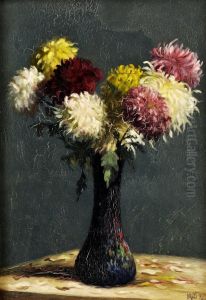Karoly Hollos Paintings
Karoly Hollos was a Hungarian artist born in 1896 who left a significant mark on the art world, especially noted for his contributions to painting and graphic design during the early 20th century. Despite the lack of widespread recognition that some of his contemporaries received, Hollos's work has been appreciated for its unique style and the way it reflects the tumultuous times he lived through. His life spanned a period of great change and upheaval, including two World Wars and the interwar period, all of which influenced his artistic output.
Hollos's early life was steeped in the rich cultural milieu of Hungary, which was then part of the Austro-Hungarian Empire. This environment nurtured his artistic talents, leading him to study at notable institutions where he honed his skills in various mediums. His work from this period shows a keen interest in exploring human emotions, social conditions, and the complexities of the modern world. As the political landscape of Europe changed, so too did the themes and techniques present in Hollos's art.
Throughout the 1920s and 1930s, Karoly Hollos's work evolved to reflect the growing tensions in Europe. His style became more expressive, often incorporating elements of Expressionism and Art Deco, which were popular at the time. This period of his career was marked by a focus on the human figure, with many of his pieces commenting on the social and political issues of the day. Despite the challenges he faced, including the rise of fascism and the outbreak of World War II, Hollos continued to produce work that was both deeply personal and reflective of the broader societal context.
Karoly Hollos's life came to a tragic end in 1945, just as World War II was concluding. The exact circumstances of his death remain unclear, but it is known that he died in a Europe that was vastly different from the one he was born into. Despite the brevity of his life, his artistic legacy endures. His paintings and graphic works are held in various collections and have been exhibited posthumously in Hungary and internationally. Hollos's ability to capture the essence of his era, with all its beauty and despair, makes his work an important part of early 20th-century European art history.

